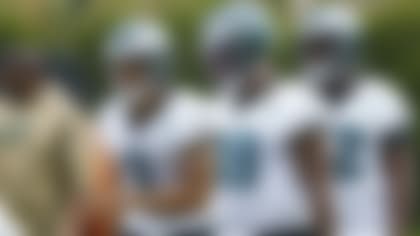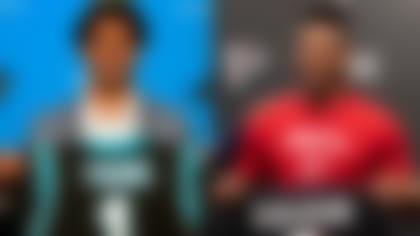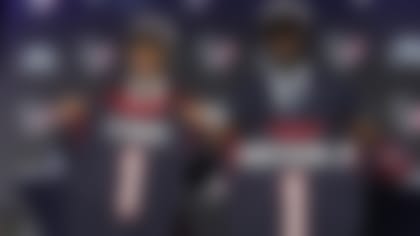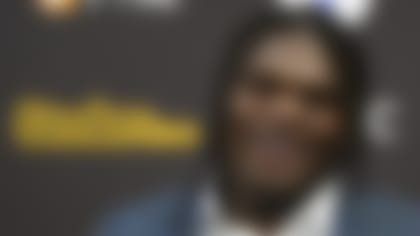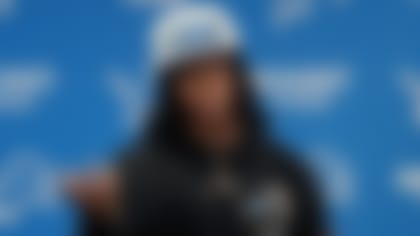NFL.com analyst Bucky Brooks is handing out grades for each team following the 2009 NFL Draft. Check back daily as he breaks down each team, division by division.
After watching the draft come and go, it is time to assess how each team fared in the league's biggest event. From the acquisition of talent to the execution of various draft strategies, teams were graded on their overall ability to play the chess game that emerges on draft weekend.
Let's take a look to see how the teams from the AFC East performed during the 2009 draft:

Buffalo Bills: B+
The Bills are desperate to end their decade-long playoff drought, and their flurry of offseason activity has been part of an aggressive effort to re-tool a roster that has fallen short of expectations the past few years. With that "make or break" philosophy in mind, the Bills continued to employ an aggressive approach as a vital part of their draft strategy.
Prior to the draft, the team parted ways with two-time Pro Bowl offensive tackle Jason Peters for a first-round pick from the Eagles (No. 28 overall) along with a fourth-round selection and a 2010 sixth-round pick. Although some would argue that a late first-round pick was not enough compensation for a player of his magnitude, the fact that the team entered the draft with two picks in the first round helped immensely in upgrading a roster with several holes on both sides of the ball.
With their first pick, the Bills attacked their biggest weakness with the selection of Aaron Maybin No. 11 overall. The former Nittany Lion adds an explosive pass rusher to a unit that only registered 24 sacks a season ago. Maybin's exceptional speed and quickness makes him an instant threat off the edge, and his ability to get to the passer will enhance the Bills' two-deep zone scheme.
The Bills added Eric Wood with their second first-round pick. The Louisville standout is lauded for his versatility, and he is expected to make an immediate contribution at center or guard. In addition, some in league circles believe Wood has the ability to play right tackle as a pro, so moving him to the outside could also be an option down the road.
Jairus Byrd, a second-round pick, gives the team a utility player in the secondary. As a talented playmaker with outstanding ball skills and awareness, Byrd is a lock to see immediate playing time as a sub-defender in the Bills' nickel defense. Additionally, the Oregon standout will make a push for the starting job at free safety.
The Bills picked up a solid interior blocker in second-round pick Andy Levitre. Though the team had to send the Cowboys a third- and fourth-round pick to get into the second round to grab Levitre, the move solidified an offensive line that has been drastically reshuffled since the end of the season.
Of the Bills' remaining picks, their biggest coup was the selection of Shawn Nelson in the fourth round. The team desperately needed a threat at tight end, and the former Golden Eagle is an ideal fit in their lineup. He is a sneaky vertical threat with outstanding hands and ball skills. As a likely first-year starter, Nelson could see a ton of balls head in his direction with Terrell Owens and Lee Evans on the outside.
The Bills have pulled out all of the stops to field a winner in 2009, and their draft strategy followed suit. With the pressure mounting on Dick Jauron to guide the team into the postseason, the Bills need their rookie class to hit the ground running.

The Dolphins orchestrated a historic turnaround last season by going from 1-15 to AFC East champions. Fueled by key contributions from a solid rookie class, the Dolphins surprised numerous foes on their way to an 11-win season. With a tough schedule ahead and high expectations abound, the Dolphins needed to hit another home run on draft day to remain among the league's elite.
With their first pick, the Dolphins picked up a talented corner in Vontae Davis. The Illinois star was considered the most gifted corner in the draft, but character concerns dropped his value in the eyes of some teams. However, if he is able to handle his business off the field, Davis could emerge as the team's No. 1 corner in his first season.
The Dolphins further addressed their secondary with the selection of Sean Smith. The physically imposing cover man has the size to match up with the top targets in the division (Patriots' Randy Moss, Jets' Jerricho Cotchery and Bills' Terrell Owens), and is primed to play a vital role as the team's nickel corner as a rookie.
Looking to take their "Wildcat" formation to the next level, the team nabbed Pat White in the second round. As a dual-threat quarterback, White gives the Dolphins a triggerman capable of taking advantage of run-heavy defensive looks opponents used to slow down the quirky attack. In addition, he may see some snaps as a receiver in a host of tricky formations.
The Dolphins attempted to address their receiver situation with the selections of Patrick Turner (No. 87) and Brian Hartline (No. 108) in the middle of the draft. Turner gives the team a big target to feature in the red zone and Hartline adds a crafty possession receiver to their lineup.
After whetting the appetites of Miami fans with their sudden ascension to the top of the AFC East, the Dolphins are banking on solid performances from a handful of rookies to keep the team in contention in 2009.

Bill Belichick has long held the reputation as one of the game's most astute coaches, but his ability to use the draft to his advantage has often been overlooked. However, after watching him relentlessly work the draft board during this year's event, he should finally get his due as one of the top personnel men in the business.
The Patriots masterfully manipulated the board through a variety of trades to accumulate 12 picks in this year's draft and two additional second-round picks in 2010. With the ammunition to re-tool an aging defense, Belichick used a handful of second- and third-round picks to add youth and athleticism to the unit.
Patrick Chung, the Patriots' top pick (No. 34), gives the team a Rodney Harrison-like hitter at strong safety. As a quasi-box defender, Chung should sniff the run while also acting as an enforcer in the middle of the field. If he can pick up the Patriots' complex scheme, he could be an instant difference maker as a rookie.
The Patriots added a big body in the middle with their selection of Ron Brace. The Boston College product adds youth to the defensive line rotation, and acts as an insurance policy against Vince Wilfork's impending free agency.
With the Patriots' third second-round pick, Belichick selected an athletic corner with exceptional overall ability in Darius Butler. The former Husky blew away scouts with his impressive showing at the combine, and is likely to compete for playing time as a sub-corner in his first season. Regardless of whether he cracks the lineup this season, he gives the Patriots a future starter to groom at the position.
Tyrone McKenzie, a third-round selection (No. 97), adds another high-motor edge player to the lineup. The South Florida standout has multi-position flexibility, and is the ideal backup linebacker in the Patriots' scheme.
With the rest of their selections, the Patriots upgraded depth at problem areas and took a few chances on some developmental prospects. The one player who could pay major dividends down the road is Brandon Tate. The North Carolina product was regarded as a late first-round talent until a knee injury ended his senior season. Tate's value was further diminished when he failed a drug test at the combine.
Nonetheless, the Patriots were willing to take a gamble on one of the most explosive receivers/returners in the draft, and the risk could pay dividends, if he plays up to his potential as a pro.
After failing to make the playoffs last season, the Patriots are poised to reclaim their spot among the league's elite, and the sound draft strategy displayed in 2009 may ensure their place at the top for years to come.

The Jets pegged Mark Sanchez as their quarterback of the future early in the pre-draft process, and cultivated a plan to snag the Southern California signal caller. When the Seahawks bypassed on Sanchez at the fourth overall pick, the Jets sent two selections (No. 17 and No. 52) and three players (Kenyon Coleman, Brett Ratliff and Abram Elam) to the Browns for the right to select the former Trojan with the No. 5 pick.
While the deal looks expensive on paper, the Jets basically landed their franchise quarterback for a second round pick and a host of reserves. For that reason alone, this deal should be viewed as a major coup for the team.
Sanchez has the personality and moxie to handle the bright lights of the City, and is the ideal quarterback to lead Rex Ryan's "swagger-licious" squad. Even though he enters the league as an inexperienced player (only 16 collegiate starts), Sanchez's knowledge of the West Coast offense will speed his transition to the pro game, and give him a chance to succeed as a young player.
With the quarterback situation suitably addressed, the team moved their efforts toward enhancing an offense that wants to bludgeon opponents with the running game. The Jets traded away three draft choices (a third-, fourth- and seventh-round pick) to the Lions to take Shonn Greene with the 65th pick.
Although the Iowa standout was regarded as a one-year wonder by some scouts, Greene gives the team an imposing downhill runner with exceptional strength and power. With Thomas Jones chirping about his contract situation, Greene could serve as the team's feature runner during his rookie season.
The Jets should be applauded for making aggressive moves to get their "guys," but the transactions prevented them from addressing needs at other areas (wide receiver). However, if Sanchez and Greene turn out to be the players that the Jets envision, the price tag for a franchise quarterback and starting running back will seem relatively small in comparison.


